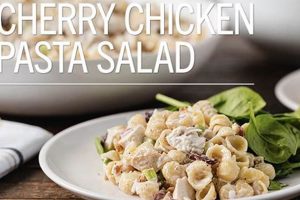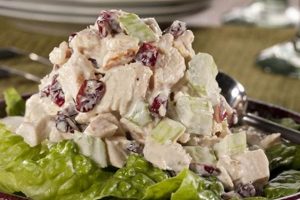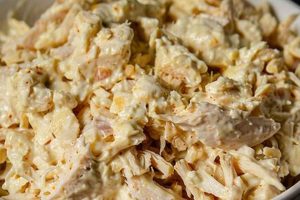A dish featuring cooked chicken, often shredded or diced, combined with mayonnaise and a pronounced lemon flavor. Common additions include celery, onion, and herbs. Variations may incorporate grapes, nuts, or dried fruit, offering a range of textures and sweetness to complement the tartness of the lemon. A simple preparation can involve combining pre-cooked chicken with store-bought mayonnaise and lemon juice, while more complex versions may involve roasting a whole chicken and making mayonnaise from scratch.
This type of salad provides a refreshing and relatively light meal option, suitable for picnics, lunches, or a light dinner. The citrus element adds brightness, balancing the richness of the chicken and mayonnaise. It’s a versatile dish that can be served on its own, in sandwiches, wraps, or as a filling for lettuce cups. Historically, chicken salad emerged as a popular dish in the mid-19th century, evolving alongside refrigeration and the increasing availability of mayonnaise. The addition of lemon likely developed as a way to enhance flavor and preserve freshness.
This exploration will further delve into specific ingredient choices, diverse preparation methods, and nutritional considerations related to this versatile and flavorful dish. From classic renditions to innovative variations, a comprehensive guide will be provided for creating a delicious and satisfying meal.
Tips for a Superior Lemon Chicken Salad
Achieving optimal flavor and texture in a lemon chicken salad requires attention to several key aspects, from ingredient selection to preparation techniques.
Tip 1: Chicken Selection is Key: Opting for high-quality chicken contributes significantly to the final result. Roasting a whole chicken or using leftover roasted chicken provides superior flavor compared to pre-cooked or boiled chicken.
Tip 2: Freshly Squeezed Lemon Juice is Essential: Bottled lemon juice often contains preservatives and lacks the vibrant flavor of fresh lemons. Zesting a portion of the lemon before juicing adds depth and complexity.
Tip 3: Balance is Crucial: The interplay of lemon, mayonnaise, and other ingredients should be harmonious. Adjust the amount of lemon juice to achieve the desired level of tartness without overpowering the other flavors.
Tip 4: Texture Considerations: Dicing the chicken into uniform pieces ensures a pleasant eating experience. Consider the texture of additional ingredients crisp celery and crunchy nuts offer contrast to the softer chicken and creamy mayonnaise.
Tip 5: Chill for Optimal Flavor: Allowing the salad to chill in the refrigerator for at least 30 minutes before serving allows the flavors to meld and deepen.
Tip 6: Herbs and Spices Enhance Flavor: Fresh herbs, such as dill, parsley, or chives, can elevate the flavor profile. A pinch of white pepper or a dash of cayenne pepper adds subtle complexity.
Tip 7: Mindful Mayonnaise Selection: The quality of the mayonnaise directly impacts the overall flavor. Consider using a high-quality mayonnaise or making your own.
By following these guidelines, one can create a lemon chicken salad that is both flavorful and satisfying. Attention to detail ensures a dish that transcends the ordinary.
These insights provide a foundation for creating a memorable culinary experience, emphasizing freshness, balance, and attention to detail.
1. High-Quality Chicken
High-quality chicken plays a pivotal role in a successful lemon chicken salad recipe. The chicken serves as the foundation of the dish, impacting both flavor and texture. Chicken possessing robust flavor enhances the overall taste profile, allowing the lemon and other ingredients to complement rather than mask its essence. Tender, moist chicken contributes to a pleasant textural experience, contrasting with the creamy mayonnaise and other additions. Conversely, bland or dry chicken diminishes the overall quality, regardless of other ingredient choices. For instance, using a roasted chicken, whether store-bought rotisserie or home-roasted, imbues the salad with a depth of flavor often absent when using pre-cooked or boiled chicken. This richness provides a canvas upon which the bright, acidic lemon notes can shine.
Furthermore, the quality of the chicken impacts how it absorbs and interacts with the other ingredients. High-quality chicken, with its inherent moisture and texture, readily absorbs the flavors of the lemon juice, herbs, and spices, resulting in a more cohesive and flavorful dish. Consider the difference between using a free-range, air-chilled chicken versus a conventionally raised, water-chilled chicken. The former tends to possess a more concentrated flavor, leading to a more pronounced and nuanced salad. Practical applications of this understanding involve selecting chicken specifically suited for this type of salad preparation. Choosing bone-in, skin-on chicken for roasting allows for optimal flavor development and moisture retention. Alternatively, opting for high-quality pre-cooked chicken, such as roasted chicken breast from a reputable source, provides a convenient yet flavorful alternative.
In summary, utilizing high-quality chicken elevates the lemon chicken salad from a simple dish to a culinary experience. The chicken’s inherent flavor and texture contribute significantly to the overall quality, impacting how the other components interact and contribute to the final product. Prioritizing chicken quality, therefore, becomes an essential consideration for anyone seeking to create a truly exceptional lemon chicken salad.
2. Fresh Lemon Juice
Fresh lemon juice constitutes a critical component within a lemon chicken salad recipe, significantly impacting the overall flavor profile and culinary experience. Its importance stems from the unique characteristics not replicated by bottled lemon juice alternatives. Freshly squeezed lemon juice possesses a vibrant acidity and complex aromatic profile absent in processed counterparts. This brightness cuts through the richness of the mayonnaise and chicken, creating a balanced and refreshing flavor dynamic. The volatile aromatic compounds present in fresh juice contribute a nuanced citrusy fragrance that elevates the sensory experience. For instance, consider the difference between using freshly squeezed lemon juice versus a reconstituted concentrate. The fresh juice imparts a clean, zesty flavor, while the concentrate often carries a slightly bitter or metallic aftertaste that detracts from the delicate balance of the salad.
Furthermore, fresh lemon juice offers subtle complexities derived from natural oils and enzymes absent in processed versions. These components contribute to the overall flavor profile, creating a depth and richness unattainable with bottled alternatives. The juice’s natural acidity also acts as a mild preservative, contributing to the salad’s freshness and shelf life. A practical example of this can be observed in the way fresh lemon juice brightens the flavors of the other ingredients. The chicken, often bland on its own, absorbs the lemon’s tartness, becoming more flavorful and palatable. The mayonnaise, which can be heavy and rich, benefits from the lemon’s acidity, resulting in a lighter, more refreshing element within the salad. The overall effect is a synergistic interplay of flavors where each component enhances the others.
In summary, prioritizing fresh lemon juice in a lemon chicken salad recipe proves essential for optimal flavor and quality. The inherent brightness, complexity, and natural properties of fresh juice contribute significantly to the sensory experience, elevating the dish beyond what can be achieved with processed substitutes. Understanding this connection allows for informed decisions regarding ingredient selection, ultimately leading to a superior culinary outcome.
3. Balanced Flavors
Balance constitutes a critical element within a successful lemon chicken salad recipe. The interplay of dominant flavorsprimarily lemon, chicken, and mayonnaiserequires careful consideration. Overemphasis on any single element can detract from the overall experience. Excessive lemon renders the salad overly tart, obscuring the subtle flavors of the chicken and other ingredients. Conversely, insufficient lemon allows the richness of the mayonnaise to dominate, resulting in a heavy, less refreshing dish. The chicken itself, while often a neutral base, contributes to the overall balance. Its inherent flavor, whether subtle or pronounced, must be considered when adjusting the proportions of other components. Achieving harmony among these elements allows each to contribute positively, resulting in a complex and satisfying flavor profile.
Consider a scenario where the recipe calls for a specific quantity of lemon juice. Simply following the measurement without considering the specific characteristics of the lemons used can lead to an unbalanced outcome. Lemons vary in size and acidity, impacting the overall tartness. Adjusting the amount of lemon juice according to these variations demonstrates a practical application of balance. Similarly, the type of mayonnaise used plays a significant role. A mayonnaise with a pronounced tang requires less lemon, whereas a milder mayonnaise may necessitate a greater quantity of lemon juice to achieve the desired balance. This interplay extends to other ingredients as well. The sweetness of dried cranberries or grapes, the savory notes of chopped celery, and the pungency of red onion all contribute to the overall flavor profile and must be considered when aiming for a harmonious balance.
In conclusion, achieving balanced flavors in a lemon chicken salad necessitates understanding the interplay of individual components and their relative contributions. Adjusting proportions based on ingredient characteristics, personal preferences, and the desired outcome ensures a well-rounded and enjoyable culinary experience. A balanced lemon chicken salad exemplifies the principle that the whole is greater than the sum of its parts. Each ingredient contributes to a harmonious flavor profile that surpasses the individual elements, creating a dish that is both refreshing and satisfying.
4. Desired Texture
Texture plays a crucial role in the overall enjoyment of lemon chicken salad. The desired texture influences ingredient preparation and impacts the final sensory experience. Consider the varying textures within the salad: tender chicken, creamy mayonnaise, and often the crispness of celery or onion. These contrasting textures create a dynamic interplay, enhancing the eating experience. A uniformly smooth or overly chunky texture diminishes this interplay, resulting in a less satisfying outcome. Texture preferences vary; some prefer a finely minced chicken salad, while others appreciate a coarser chop. Understanding this allows for customization, tailoring the salad to individual preferences.
The method of preparing the chicken directly impacts the final texture. Shredding cooked chicken yields a finer, more delicate texture, whereas dicing creates a coarser, more substantial mouthfeel. This choice impacts how the chicken interacts with other ingredients. Shredded chicken absorbs the dressing more readily, potentially leading to a softer overall texture. Diced chicken retains its structure, providing a more distinct textural contrast. Furthermore, the addition of ingredients such as grapes, nuts, or dried fruit introduces further textural complexity. The interplay between soft grapes, crunchy nuts, and tender chicken contributes to a more dynamic and engaging sensory experience. Failing to consider these textural nuances can result in a monotonous salad lacking depth and interest.
In conclusion, achieving the desired texture in lemon chicken salad requires thoughtful consideration of ingredient preparation and the interplay of various textural elements. Understanding how different preparation methods and ingredient choices influence the final texture allows for customization and optimization of the sensory experience. Whether smooth and creamy or chunky and vibrant, the desired texture contributes significantly to the overall enjoyment and satisfaction derived from this versatile dish.
5. Proper Chilling
Proper chilling constitutes a crucial step in preparing lemon chicken salad, significantly impacting both food safety and flavor development. Chilling allows the flavors of the various ingredientschicken, lemon juice, mayonnaise, and any additionsto meld and harmonize. This integration creates a more complex and nuanced flavor profile compared to a freshly made salad. The chilling process also allows the chicken to absorb the lemon juice and other flavors more thoroughly, resulting in a more evenly distributed taste and a more enjoyable culinary experience. From a food safety perspective, chilling inhibits bacterial growth, ensuring the salad remains safe for consumption. Mayonnaise-based salads are particularly susceptible to bacterial contamination due to their high moisture content and protein levels. Maintaining a safe temperature below 40F (4C) minimizes this risk, preserving the quality and safety of the salad. For instance, a salad left at room temperature for an extended period, particularly in warmer climates, provides an ideal environment for bacterial proliferation, potentially leading to foodborne illness. Proper chilling mitigates this risk, ensuring the salad remains safe to consume.
The duration of chilling also influences the salad’s quality. A brief chilling period of 30 minutes allows for initial flavor integration and temperature reduction. However, extending the chilling period to several hours, or even overnight, allows for more profound flavor development. The longer chilling time enables the flavors to deepen and meld, resulting in a more balanced and harmonious final product. This enhanced flavor development becomes particularly noticeable when using complex flavor combinations or incorporating ingredients like fresh herbs, which release their aromatic compounds more fully during prolonged chilling. Consider the difference between a salad chilled for 30 minutes and one chilled for four hours. The latter typically exhibits a more nuanced flavor profile, where the individual ingredients harmonize more effectively. Practical applications of this understanding involve planning ahead when preparing lemon chicken salad for events or gatherings. Chilling the salad overnight allows for optimal flavor development, ensuring a more satisfying culinary experience for guests.
In summary, proper chilling plays a vital role in lemon chicken salad preparation, contributing to both food safety and flavor optimization. Chilling not only inhibits bacterial growth, ensuring safe consumption, but also allows the flavors to meld and mature, creating a more complex and satisfying culinary experience. Understanding the impact of chilling duration and temperature control allows for informed decision-making, ultimately leading to a safer and more flavorful lemon chicken salad.
Frequently Asked Questions
The following addresses common inquiries regarding lemon chicken salad preparation, offering practical guidance for optimal results.
Question 1: What type of chicken is best suited for lemon chicken salad?
Roasting a whole chicken or using leftover roasted chicken yields optimal flavor. High-quality pre-cooked chicken, such as roasted chicken breast, offers a convenient alternative. Boiled or poached chicken tends to be less flavorful.
Question 2: Can bottled lemon juice be substituted for fresh?
While bottled lemon juice can be used, fresh lemon juice is strongly recommended. It possesses a brighter, more complex flavor profile than bottled varieties, significantly enhancing the overall quality of the salad.
Question 3: How long can lemon chicken salad be stored safely?
When properly refrigerated in an airtight container, lemon chicken salad typically remains safe for consumption for up to three to five days. However, it’s crucial to monitor for any signs of spoilage, such as off-odors or changes in texture.
Question 4: How can one adjust the tartness of the salad?
The amount of lemon juice dictates the tartness level. Start with a smaller quantity and gradually add more until the desired level of acidity is achieved. Tasting and adjusting throughout the process ensures a balanced flavor profile.
Question 5: What are common additions to enhance the salad’s flavor and texture?
Common additions include chopped celery, red onion, grapes, dried cranberries, toasted nuts, and fresh herbs such as dill or chives. These ingredients provide textural contrast and complementary flavors, enhancing the overall sensory experience.
Question 6: Can lemon chicken salad be frozen?
Freezing is not generally recommended. The mayonnaise-based dressing can separate and become watery upon thawing, negatively impacting the texture and overall quality of the salad. It is best enjoyed fresh or within a few days of preparation.
Addressing these common inquiries provides a foundation for successful lemon chicken salad preparation. Understanding these aspects allows for informed ingredient choices and preparation techniques, ultimately resulting in a more enjoyable culinary experience.
Further exploration of specific recipe variations and serving suggestions follows.
Lemon Chicken Salad Recipe
This exploration of lemon chicken salad recipes has highlighted the critical elements contributing to a successful outcome. From the selection of high-quality chicken and the importance of fresh lemon juice to the careful balancing of flavors and consideration of texture, each component plays a vital role. Proper chilling techniques further enhance both food safety and flavor development, ensuring a satisfying culinary experience. The versatility of this dish, adaptable to various flavor profiles and dietary preferences, positions it as a timeless classic.
Ultimately, a well-executed lemon chicken salad recipe transcends mere sustenance, offering a testament to the transformative power of culinary artistry. Attention to detail and a focus on quality ingredients elevate this seemingly simple dish to a culinary creation worthy of appreciation. The potential for creative exploration within this framework remains vast, inviting further experimentation and innovation within the culinary landscape.






